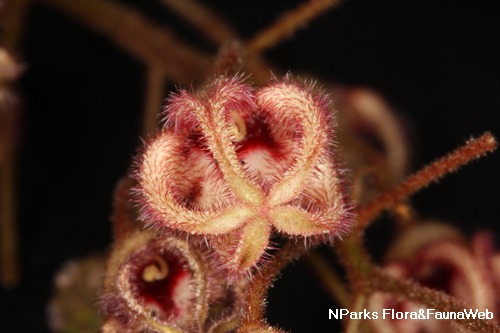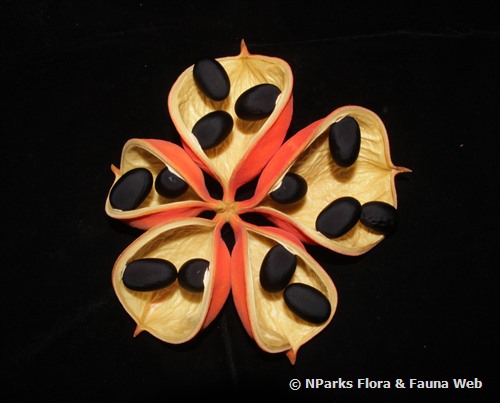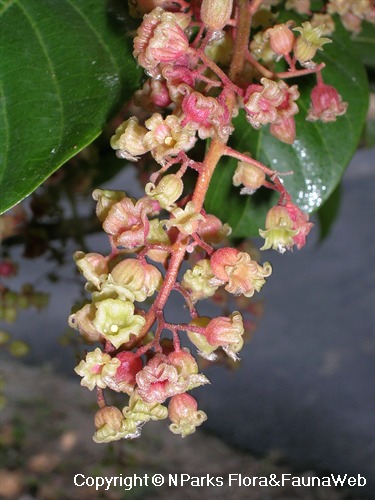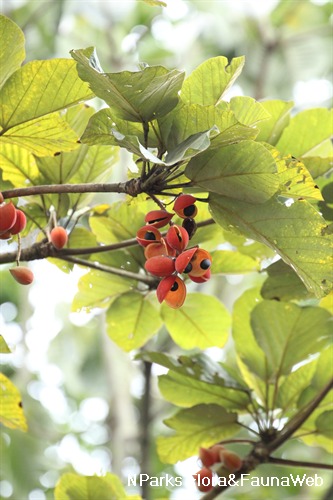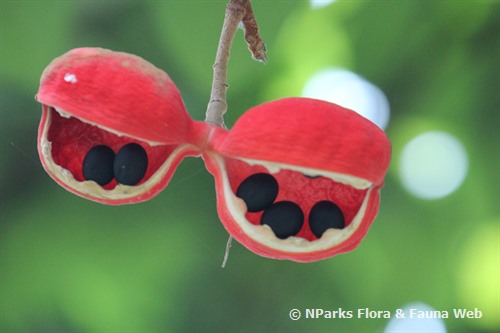
Back
Sterculia cordata Blume
| Family Name: | Malvaceae |
| Common Name: | Kelumpang, Kembang |
Sterculia cordata or Kelumpang is a native tree of Singapore. Leaves are egg to spoon or broadly elliptic leaves with a heart-shaped base, dense star-like hairs are found on the underside. Drooping clusters of bell-shaped, 5-lobed flowers, pink, reddish to orange coloured with a dark red centre found at the tip of the branches. The fruit is a red, woody follicle that spilt upon maturity revealing its elliptic dark seeds.
Name
Classifications and Characteristics
| Plant Division | Angiosperms (Flowering Seed Plants) (Dicotyledon) |
|---|---|
| Plant Growth Form | Tree (Medium (16m-30m), Big (>30m)) |
| Mode of Nutrition | Autotrophic |
| Maximum Height | 45 m |
Biogeography
| Native Distribution | Sumatra, Peninsular Malaysia, Java, Borneo, the Philippines |
|---|---|
| Native Habitat | Terrestrial (Primary Rainforest, Secondary Rainforest) |
| Preferred Climate Zone | Tropical |
| Local Conservation Status | Native to Singapore (Critically Endangered (CR)) |
Description and Ethnobotany
| Growth Form | It is a tree that is briefly deciduous, generally to 20 m tall. In Borneo, it can reach to 45 m tall. It has horizontal branches in whorls and short buttresses at the base of the trunk. |
|---|---|
| Foliage | Leaves are simple, spirally arranged and clustered towards the end of the twigs held on a petiole of 2 - 5 cm long covered in dense star-like hairs. The leaves are egg to spoon-shaped to broadly elliptic, measuring 8 - 30 cm long by 5 - 19 cm wide with a shallow heart-shaped to box-shaped base and abrupt to broadly pointed tip. Dense, star-like hairs are found on the underside, the upper surface remains smooth. |
| Flowers | Flowers are monecious where the female and male parts are borne on separate flowers. They are produced in drooping clusters of bell-shaped flowers, pink, reddish to orange coloured with a dark red centre. Star-like hairs are found on both sides of the 5-lobed flowers. Female flowers measure at 4 - 8 mm long, slightly larger than male flowers of 3 - 5 mm long. |
| Fruit | The fruit is pendulous, woody, oblong follicle in groups of up to 5, measuring 9 cm long, 5 cm wide. Upon maturity, the fruit turns red and splits open to reveal its dark elliptic seeds. |
| Habitat | Occurs in primary and secondary forest in low altitude, sometimes on limestone, often in seasonally flooded areas. <1,2> |
| Associated Fauna | Its flowers are insect-pollinated. |
| Cultivation | It can be propagated by seed. |
| Etymology | Latin, cordatus, means heart shaped, referring to the leaf base. |
| Ethnobotanical Uses | Timber & Products: It produces lightweight softwood. |
Landscaping Features
| Desirable Plant Features | Ornamental Flowers |
|---|---|
| Landscape Uses | Suitable for Roadsides, Parks & Gardens |
| Plant & Rootzone Preference or Tolerance Remarks | Sandy soil |
Fauna, Pollination and Dispersal
| Pollination Method(s) | Biotic (Fauna) |
|---|
Plant Care and Propagation
| Light Preference | Full Sun |
|---|---|
| Water Preference | Moderate Water |
| Plant Growth Rate | Moderate |
| Propagation Method | Seed |
| Propagation Method Remarks | Presence of hard seed coat makes it difficult to germinate. Part of the seed coat can be carefully removed to allow water to enter without damaging the embryo. |
Foliar
| Foliage Retention | Evergreen |
|---|---|
| Mature Foliage Colour(s) | Green |
| Mature Foliage Texture(s) | Hairy / Hirsute |
| Foliar Type | Simple / Unifoliate |
| Foliar Arrangement Along Stem | Spiral |
| Foliar Attachment to Stem | Petiolate |
| Foliar Shape(s) | Non-Palm Foliage (Elliptical, Oblong, Obovate, Ovate) |
| Foliar Venation | Pinnate / Net |
| Foliar Margin | Entire |
| Foliar Apex - Tip | Acuminate, Acute, Rounded |
| Foliar Base | Cordate, Truncate / Square |
Non - Foliar and Storage
| Bark Colour(s) | Orange-brown, Dark brown |
|---|---|
| Mature Bark Texture | Cracked, Scaly |
| Stem Type & Modification | Woody |
| Root Type | Underground (Tap Root) |
Floral (Angiosperm)
| Flower & Plant Sexuality | Unisexual Flowers , Monoecious |
| Flower Colour(s) | Red, Orange, Pink |
|---|
| Flower Texture(s) | Hairy / Hirsute |
| Flower Grouping | Cluster / Inflorescence |
| Flower Location | Terminal |
| Flower Symmetry | Radial |
| Individual Flower Shape | Campaulate / Bell-shaped |
| Inflorescence Type | Panicle |
| Flowering Habit | Polycarpic |
Fruit, Seed and Spore
| Mature Fruit Colour(s) | Red |
|---|---|
| Fruit Classification | Simple Fruit |
| Fruit Type | Dehiscent Dry Fruit , Follicle |
| Mature Seed Colour(s) | Black, Brown |
| Seed Quantity Per Fruit | Few (1-5), Moderate (6-10) |
References
| References | <1> Gardner, S., Sidisunthorn, P. & Chayamarit, K. (2016), Malvaceae (Sterculiaceae). Forest Trees of Southern Thailand, vol. 2, pp. 1169. Bangkok: Kobfai Publishing Project. <2> Wilkie, P & Berhaman, A. (2011). Sterculiaceae. Tree Flora of Sabah and Sarawak, vol 7., pp. 390-391. Selangor: Forest Research Institute Malaysia. |
|---|
Image Repository
Others
| Master ID | 29419 |
|---|---|
| Species ID | 3728 |
| Flora Disclaimer | The information in this website has been compiled from reliable sources, such as reference works on medicinal plants. It is not a substitute for medical advice or treatment and NParks does not purport to provide any medical advice. Readers should always consult his/her physician before using or consuming a plant for medicinal purposes. |

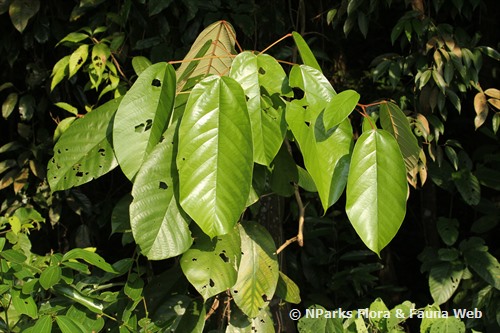
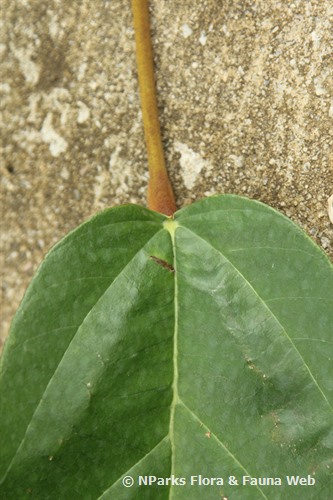
-(19).jpg)
-(1).jpg)
-(8).jpg)
-(5).jpg)
